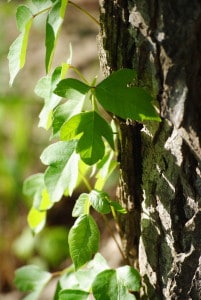Gopher, fire ant, and poison ivy offensive foiled by rain
The true story follow-up to Part I of this post is that my plan got almost completely rained out. After the rain fell all morning, and I allowed a few hours for drying time, all I managed to do was spray some poison ivy with Round Up, and hit a few ant mounds with Amdro along the way. Unfortunately, the rain fell again that night, and hardly any of the herbicide had time to take effect. The ants are an ongoing battle but at least they seem to be retreating.
While the rain continued for days, postponing my tasks, a long anticipated vacation came around, and we left for 2 weeks. Little Piney was loved and visited by friends and family who monitored the nest boxes and looked out for things, and they all told us how green it was out there!
On our return it was green all right– like a jungle! Little Piney was lush with native grasses, wildflowers, dewberries, and healthy stands of poison ivy all along the lake. Still scarred by my last encounter with poison ivy, I was very careful, especially since there was a vulnerable gap between my boots and my shorts. I did not think for one minute of the possibility that it was time for chiggers to be out and busy. I had forgotten about chiggers, and how badly they itch. Now I’ve been reminded every day for a whole week.
Chiggers
I researched chiggers to determine what was fact and what was myth. When I was growing up we painted nail polish over the bites to kill the chiggers or “red bugs.” Apparently that was unnecessary because the chigger is usually long gone before the itching starts. Chiggers are the larvae of a mite of the family Trombiculidae. They are arachnids like ticks and spiders. These barely visible hairy red mites are found throughout the world and can be traced back to 6th century China. According to Wikipedia “Trombiculidae mites go through a life cycle of egg, larva, nymph, and adult. The larval mites feed on the skin cells of animals [and humans]. After crawling onto their hosts, they inject digestive enzymes into the skin that break down skin cells. They do not actually “bite” but instead form a hole in the skin called a stylostome and chew up tiny parts of the inner skin, thus causing severe irritation and swelling. The severe itching is accompanied by red, pimple-like bumps (papules) or hives and skin rash or lesions on a sun-exposed area. For humans, itching usually occurs after the larvae detach from the skin.”
The best thing to do is to avoid the chiggers as best you can, and if you can’t wash clothing in hot water and detergent, and shower immediately. After the fact, topical creams can help the itching. I got the best relief from Sting-eze. The itching actually rivals the poison ivy in intensity.
Call in reinforcements
So, we are behind on taming Mother Nature, and can admit when we need help. Tomorrow I have reinforcements–a man with a tractor that works (ours is broken), who knows how to run his tractor (we don’t), who knows how to fix our tractor (maybe), who will cheerfully and fearlessly spray the poison ivy, and who thinks he can fix whatever we mis-set on our watering troughs for the game! And, he is going to mow pathways to the nest boxes so that I can reach them without wading through chigger territory!
If all this happens, he will be Little Piney’s own super hero.
We’ll learn to run the tractor, eventually. I’ll mark “chiggers” on next year’s calendar as a reminder along with “poison ivy” to remind myself of their return. We’ll leave the water valves alone forever after. No more spring vacations, ever. And I will not go walking through tall grass without insect repellant and long pants again.

.